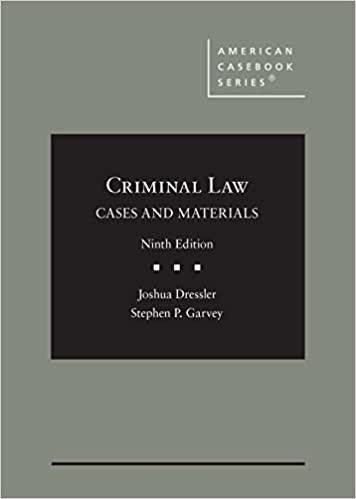Question
(1) Which of the following best reflects the views of the majority and/or dissent in Palsgraf v. Long Island Railroad Co. (i.e. the case involving
(1) Which of the following best reflects the views of the majority and/or dissent in Palsgraf v. Long Island Railroad Co. (i.e. the case involving the fireworks exploding on the train platform)? A. The majority held that a reasonable jury could not find the defendant caused the harm to the plaintiff and therefore analysis of duty was not necessary. B. The majority held that the defendants did owe a duty to the plaintiff but that no reasonable jury could find defendant caused the harm to the plaintiff. C. The dissent believed that the defendants did owe a duty to the plaintiff and that a reasonable jury could find that the defendant caused the harm to the plaintiff D. The dissent believed that the defendants did owe a duty to the plaintiff but that no reasonable jury could find that the defendant caused the harm to the plaintiff. E. None of the above is accurate. 2. Taylor, Justin and Megan are fellow students in a science class. As part of a class experiment, they want to test the relative falling speed of a bowling ball and basketball. Standing on the balcony of an apartment building, Taylor and Megan drop the balls simultaneously, while Justin stands below with a stop watch. Zach and Greg, two brothers in the middle of an argument, happen to be walking by at the time of the experiment. Zach, in the heat of the argument, shoves Greg into the path of the bowling ball. The ball lands on his toe, causing an injury. If Megan dropped the bowling ball, what is her best defense against a suit brought by Greg? A. Megan has no duty of care towards Greg B. Greg is an unforeseeable plaintiff C. Running a science experiment for class is not negligent D. The experiment was carefully designed E. Megan's actions were not the proximate cause of Greg's injury 3. Griffin lives in an apartment with two other roommates. One day the police arrive to execute a search warrant against one of his roommates and find over 100 sheets of blotter paper in the living room, each containing a hit of LSD. If you were defending Griffin for possession charges, which of the following facts would be most helpful? A. Griffin did not have any LSD on his person when the police came to search the apartment. B. A drug test revealed that Griffin did not have any LSD in his system when the police searched the apartment. C. When the police searched the apartment, Griffin was away at an in-person class. D. One of Griffin's roommates had marijuana, a scale, and over $500 in cash in her dresser.
2 E. The sheets of blotter paper were tucked in a backpack belonging to one of Griffin's roommates. 4. A cruise company was assessed a hefty $500,000 fine for failing to have functioning life boats available on one of its ships. Two weeks later, a meteor hit the ship and killed all 100 passengers instantly. The family of one of the victims heard that the cruise company had been negligent in maintaining its lifeboats, and decided to pursue a wrongful death claim. Which element of their claim will be the most problematic? A. Damages B. Breach of duty C. Causation D. Duty E. Products Liability 5. Victor accidentally bumps into Doug on a sidewalk. Then, Doug shoves Victor. Victor and Doug trade blows until Doug lands a massive punch to Victor's temple, sending him to the ground dead. Doug flees the scene. An autopsy later reveals that the punch to the temple caused Victor's death. A prosecutor thereafter charges Doug with first degree murder. Which of the following is most accurate? A. Doug is guilty of first degree murder if he intended to kill Victor when he punched him B. Doug is guilty of first degree murder if he was aware there was a significant risk that Victor would die when he punched him. C. Doug is guilty of first degree murder if he intended to kill Victor when he punched him or if he was aware there was a significant risk that Victor would die when he punched him. D. Doug is not guilty of first degree murder because there is no evidence of premeditation E. Doug is not guilty of first degree murder because he did not use a deadly weapon.
Step by Step Solution
There are 3 Steps involved in it
Step: 1

Get Instant Access to Expert-Tailored Solutions
See step-by-step solutions with expert insights and AI powered tools for academic success
Step: 2

Step: 3

Ace Your Homework with AI
Get the answers you need in no time with our AI-driven, step-by-step assistance
Get Started


